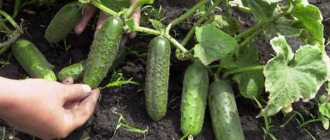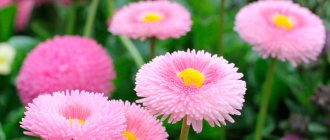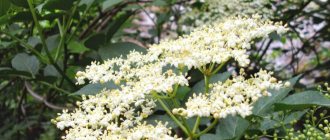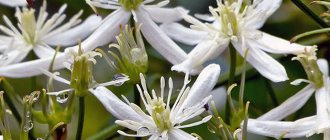We have compiled a list of 9 clematis that are not fussy about care and tolerate frosts down to –30°C. There are terry, and simple, and plain, and two-color, and snow-white, hot pink - there is plenty to choose from!
The main problem faced by flower growers in the middle zone and Moscow region is cold winters, when temperatures can drop to –30°C. That is why, when choosing a clematis variety for your garden, you should first of all evaluate its resistance to frost.
This region belongs to winter hardiness zone 4-5; accordingly, the selected plants must confidently tolerate the temperatures of this climatic zone. We offer you a selection of 9 luxurious varieties of clematis that meet this criterion.
Allanah
Clematis Allana is a stunning beauty with rich purple petals. Its inflorescences are large and simple.
This plant belongs to pruning group 3, that is, it blooms for a long time on young shoots.
| Plant height (cm) | Petal coloring | Flower size | Trimming group | Flowering time |
| 200-300 | Dark purple | Large | 3 | July-October |
Preparatory activities before wintering
Preparing plants for winter includes the following activities:
- Hill up the soil to a height of 15 cm with the addition of compost, humus or wood ash.
- Carefully cover the root collar.
- The shoots are removed from the supports and carefully laid out.
- When a stable temperature below 0 ° C occurs, the flowers are covered. For this, materials are used that provide ventilation conditions inside the bush and prevent it from being blocked: wooden boxes, spruce branches, cut branches. In areas with harsh winters, it is recommended to scatter additional dry leaves, sawdust, pine needles, and peat over the first layer of shelter.
The shelter is removed in the spring, when the threat of return frosts has passed. Then they remove the hillock. If, despite all the attempts made, the clematis is frozen out, there is no need to rush to uproot it. Young shoots may develop in the root system.
For beginners, the process of growing clematis may seem complicated. But the result will exceed all expectations when clematis flowers appear, and with them the opportunity to admire the abundance of shapes and colors for many years in your own garden.
Akaishi
Clematis of the Japanese variety Akaishi impresses with the unusual color of its petals: they are dark pink in the center and purple at the edges. The length of its shoots is quite impressive - about 2-3 m. However, Akaishi clematis is often grown in containers.
| Plant height (cm) | Petal coloring | Flower size | Trimming group | Flowering time |
| 200-300 | Purple with a dark pink stripe in the center | Large | 2 | May-June, August-September |
The most unpretentious variety of clematis
There are enough varieties of it, you can choose any:
Manchurian
- an ornamental plant resistant to severe cold, blooming luxuriantly with fragrant white flowers, reaching a height of two meters. The part of it located above the ground disappears in the autumn, and in the spring it quickly begins to grow, producing many young branches. The variety was bred specifically for temperate latitudes with cold climates. It tolerates any frost well.
Bush
- the most popular type among people. Such a lobed shrub has become the dream of any clematis collector. There are a lot of branches growing, and they reach a height of up to a meter. The flowers, which bloom in August, are rich yellow and have a diameter of up to four centimeters. The liana is evergreen, unpretentious, with non-dying shoots.
The president
– characterized by abundant and long flowering. The blooming star-shaped flowers have a rich purple hue. With proper care, this vine blooms twice - May-June and August-September. Thanks to his unpretentiousness, the President adapts well to different climates.
Burning
– a long-growing deciduous species with lush flowering, decorative beauty and winter hardiness. Flowering begins in early summer and ends in August. Climbs well on any support. The flowers impress with a strong, delicate aroma.
Jacquemin
- an original hybrid with huge flowers, obtained from purple, woolly and Henderson clematis. The type with woody stems is the most popular due to the size of the flowers - up to fifteen centimeters. It is characterized by cold resistance and a longer flowering period - from mid-summer to mid-autumn. It perfectly frames gazebos, pergolas, arched and other garden structures. This clematis is one of a kind. Its main difference is twenty different large-flowered species that do not require careful care.
In our latitudes, clematis from the Jacqueman variety take root well:
Gypsy Queen
- a moderately growing vine, its height can be up to three to four meters. Its peculiarity is abundant flowering. The color of the flowers is a dark purple hue, which can turn into purple. Their diameter is fifteen centimeters. It develops well near the walls of houses, on the lattice of gazebos, near fences, and can also climb bushes, coniferous, deciduous trees and any supports.
Blue flame
– the full color appears in autumn, the flowers are large, up to eighteen centimeters in diameter, the wide petals are bright blue with light veins. An adult plant reaches a height of three meters, and to give the vine a beautiful shape you just need to increase the support.
Viola
– a variety from Estonia is distinguished by long stalks with velvety dark purple flowers up to twelve centimeters in diameter, with yellow-green stamens. The height of the bush reaches three meters and ceases to please in August.
Rouge Cardinal
– grows two meters in height, the diameter of the blooming flowers is ten centimeters, the color is crimson-red, the stamens are red. Blooms from July to September.
Such clematis decorate recreation areas, create romance and comfort on terraces or on any other area.
Anna German
Clematis Anna German is gentle, like the image of the singer after whom it is named. He cannot help but captivate with the lilac-blue range of flowers. The shoots of this plant can grow up to 2.5 m.
| Plant height (cm) | Petal coloring | Flower size | Trimming group | Flowering time |
| 120-250 | Lilac-blue with light stripes | Average | 3 | July-September |
What do you need to know when planting a beautiful vine?
You should not be afraid to plant such a perennial. Growing it is not difficult, you just need to take into account some features when planting:
- it is a fast-growing vine, which adds fifteen centimeters to the shoot per day
- his comfortable place is sunny, windless
- the soil should be drainage with plenty of organic matter
- the flower drinks water well, but does not like it to stagnate
- the ground must be permeable
- due to the lack of a long root system, it is better to cover it for wintering
- he has a positive attitude towards feeding
- you need to retreat 70 cm from the wall of the house or fence
- When planting, the roots should be spread out
- between several bushes a distance of one and a half meters is maintained
- lattice, pergola, trellis are installed from east to west
- If the roots are dry when purchased, it is better to lower the bush into water so that it gains enough moisture.
- the hole should be made according to the size of the bush. For a large one it should be 70x70 cm and at least 70 cm deep for good root development
- When purchasing, you should consider climate zones
If such a list does not scare you, then in the near future clematis will delight you with abundant flowering and decorate your site.
Azure Ball
Clematis of this variety of Polish selection attracts with lilac double inflorescences with a diameter of 15-20 cm.
- Terry varieties of clematis - photos, names, descriptions
A selection of 23 varieties of clematis with double flowers.
This plant is great for growing in containers.
| Plant height (cm) | Petal coloring | Flower size | Trimming group | Flowering time |
| 200 | Purple blue | Large | 2 | May-July |
Basic recommendations for growing, planting and care
The changeable cool climate of the Moscow region requires the gardener to have certain skills and knowledge in successfully growing clematis. Compliance with the main requirements and criteria will help you create a beautiful flowering corner in the garden without problems and excessive effort.
Deadlines
The best time for planting in the region is considered to be the second half of spring: the time when return frosts are no longer predicted, or in late August - early September.
You can replant clematis throughout the growing season. The main thing is that the stem has already become lignified, and there is still enough time left before the onset of cold weather, which will allow it to take root and adapt to new growing conditions.
Bare-rooted seedlings are planted earlier than those grown in molds. It is also worth remembering that plants in their first year of life must be covered for the winter to prevent them from freezing.
Related article:
How to feed clematis in spring for long and luxurious flowering
Place
It is recommended to choose slightly shaded areas with protection from drafts and gusty winds. Clematis loves warmth, but planting in areas with direct sunlight will cause the color of the petals to fade.
For many types of climbing vine-like clematis, it is necessary to install support structures, trellises or nets with a height of at least 2 m. It is better to fix the shoots with soft garters (rope, tape, thread). This will allow them to grow without intertwining with each other, and also to receive full coverage.
It is not recommended to plant clematis very close to wired fences and blank walls of houses, in dark places with high humidity. It develops and grows better in places with support and free access to light and air from all sides.
Clematis can grow in the same place for more than 10 years. Since the transplant is quite painful, and the process of adaptation to changed conditions can take up to 2 years, you should carefully study in advance all the existing conditions for growth and development.
Related article:
Clematis for your garden: Description, types and secrets of growing
The soil
One of the main criteria for successful growth is suitable soil. It should be loose, fertile, neutral or slightly alkaline. Salty soils or highly acidic soils are not suitable.
It is also undesirable to plant the plant in areas with high groundwater levels, swampiness and stagnant water.
Required work:
- Digging the soil.
- Removing weeds and debris.
- Preparing a hole measuring 70*70*70 cm.
- Laying a drainage layer (crushed stone, pebbles, expanded clay, broken brick) 10-15 cm wide.
- Filling the recess with a mixture of the following components - sand, peat, mineral fertilizer (100-150 g) and wood ash (2 tbsp.).
Reproduction
There are the following types of clematis propagation:
- By layering. In the near-trunk zone of the stem, it is necessary to make a depression up to 10 cm in length. Place a selected powerful young shoot into it. Cover the nodes with soil and leave the green mass open. Secure with wire staples. After watering, constantly monitor the soil moisture level.
- Seeds. Can only be used to obtain species or wild plants. Direct sowing into the ground is more often used, since growing in containers and subsequent picking of seedlings is less tolerated.
- By cuttings. Cutting is carried out before the buds bloom - in spring or early summer. For rooting, lignified or green shoots are used, which are cut at a height of 30 cm from the soil surface.
Find out more about how to grow clematis from seeds
Methods such as grafting, dividing and pinning require certain skills and knowledge from the summer resident.
Related article:
Proper planting of clematis
Clematis seeds
Landing
Initially, it is necessary to check the condition of the roots: if drying is detected, they should be placed in a container with water for 2 hours. Many gardeners also practice soaking in growth stimulants.
Place the seedling in a prepared hole on a small hill, distribute the roots over the surface of the soil and cover it with soil. At a distance of about 20 cm, it is necessary to leave a small depression for subsequent watering. When planting, you need to pour water until it is completely filled. This irrigation mechanism ensures that water is supplied not to the roots themselves, but to the soil around them.
It is important that the growth point of young stems is deepened by 5-7 cm, mature, mature - by 8 cm.
To shelter a young seedling from the burning rays of the sun, it is recommended to install a protective structure made from scrap materials.
The recommended interval when planting several seedlings in a row is up to 1.2-1.5 m from each other. This distance will allow each of them to fully develop without creating shadows or obstacles.
Related article:
Don't forget to do this in the fall with clematis
The root system of the plant develops horizontally. For additional protection, ground cover or annual species, such as nasturtium, calendula or marigolds, are planted next to clematis.
In particularly dry summers, in order to avoid overheating of the soil, gardeners mulch the soil around the bush with cut grass or sawdust.
Watering and care
Depending on the quality and composition of the soil in the Moscow region, adult plants require watering approximately once every 7 days. To do this, use warm water, settled in containers, at the rate of 2-4 buckets per 1 clematis over 2-3 years old. This volume of liquid can moisten the soil to a depth of 60-70 cm, which is especially important for tall vines. During drought, they will need to be watered more often and more.
The best option for watering is to use plastic bottles or tubes cut on both sides. Dig containers around the perimeter of the near-trunk zone at a distance of 20-30 cm from the stem, fill with drainage (expanded clay or crushed stone is most often used). When watering, pour water into them with a watering can - this method will ensure uniform moisture of the soil around the root system and will not allow the liquid to stagnate.
Related article:
Clematis - care and pruning in autumn, preparation for winter
Timely weeding, loosening and removal of inflorescences that have already faded will help the clematis grow and develop to its fullest.
Top dressing
The main prohibitions when feeding are fresh manure, humus and the introduction of peat with high acidity into the soil.
Plants in their first year of life are usually not fertilized, provided that the soil is first prepared and nutrients are added. With the onset of the new season, fertilizing is carried out approximately 4-5 times:
- May – mix 1 liter of mullein with 10 liters of water and 1 tbsp. l. urea.
- During the period of bud formation, treatment is carried out with the growth stimulator Bud.
- June (flowering) – 10 g Agricola per 10 liters of water and 1 tbsp. l. potassium sulfate.
- Completion of flowering - organic or complex mineral fertilizers.
- August – potassium-phosphorus mixtures.
Trimming
In the Moscow region, the procedure is carried out in late October - early November. Depending on the type of pruning, there are the following groups of clematis:
- No trimming. Old shoots that have bloomed in the spring should not be pruned. You can remove dry branches and shorten the tops. If excessive growth of the bush is observed, the pruning height is no more than 1 m.
- Weak. For plants planted last year, it is necessary to carry out manipulation at a height of up to 30 cm. Two-year-old bushes and older ones - from 1.5 m.
- Strong. The recommended level for pruning shoots is 20-50 cm from the soil surface (approximately above 2-3 pairs of buds).
Related article:
The magic of scarlet in the garden: 5 varieties of beautiful clematis with red flowers
If it is impossible to independently determine the group, you can use universal pruning with alternating short and long shoots.
Preparing for winter
You need to start covering clematis for the winter in the region from the end of October - beginning of November. The process consists of:
- Trimming.
- Hilling up the bush (15 cm) with the addition of ash or compost.
- Covering the root collar.
- Layout of vines removed from supports on the ground.
- Uniform covering with spruce branches, fallen dry leaves, sawdust or peat as the temperature drops below zero degrees. Some summer residents use insulation from artificial materials for garden purposes.
- Additional snow cover.
Removal of the protective layer must be carried out gradually, starting in April. This will allow the vine to quickly adapt and recover after winter. First you need to open places for ventilation and air access, then after the threat of return frosts - insulation and after a few days a hilling layer of soil.
Barbara
Barbara is another variety originally from Poland. This one can handle some shade and doesn't mind large containers.
It grows quickly, so it is suitable for landscaping gazebos and fences.
| Plant height (cm) | Petal coloring | Flower size | Trimming group | Flowering time |
| 200-300 | Light pink | Average | 2 | May-June, July-September |
Betty Corning
Clematis of this variety can grow up to 4 m in length! It can be safely planted near arches and pergolas.
The pride of this plant is its bell-shaped inflorescences of a purple hue.
| Plant height (cm) | Petal coloring | Flower size | Trimming group | Flowering time |
| 300-400 | Lilac | Average | 3 | June-September |
There are clematis:
Hybrid
These are well-developed perennial vines and subshrubs. Clinging with branches and tips of leaves to any support, they grow up to three meters in length. Their inflorescences consist of single flowers up to twenty centimeters in diameter, which after flowering turn into fluffy round fruits. The plant impresses with its decorativeness, thanks to its beautiful dissected leaves, and during flowering the bush looks like a blooming bonfire. This species needs a windless, sunny place and powerful support, because the weight of an already mature bush can be more than one hundred kilograms.
Large-flowered
A wonderful decorative group of vines with flowers up to twenty centimeters, of various bright, rich colors. They are most popular in homesteads; they create beautiful compositions in various landscape designs.
These groups, depending on the growing season and other significant differences, are also divided into several subgroups.
Duchess of Edinburgh
This clematis is a real aristocrat. It is no less majestic than its name, which translates as “Duchess of Edinburgh” (and the bearer of this honorary title is none other than Queen Elizabeth II herself). It is impossible not to fall in love with the lush double inflorescences of a snow-white hue with a soft yellow center.
This clematis is frost-resistant and has good and fast growth. The flowers on last year's shoots are double, while on the current year's shoots they are simple.
| Plant height (cm) | Petal coloring | Flower size | Trimming group | Flowering time |
| 200-300 | White | Large | 2 | May June July August |
Proper plant pruning
Anyone who is perplexed as to why clematis does not bloom should look for the reasons precisely in pruning errors. Since pruning shoots is of no small importance for the growth of the plant and its flowering. The shoots should be trimmed with a clean and well-sharpened device (garden shears or pruning shears). Sanitary pruning can be done at any time, removing dry, damaged and burnt parts of the vine.
However, the gardener should pay special attention to autumn pruning. It is she who sets the tone for the appearance of clematis next year.
Plant pruning is classified according to international standards.
- A - unedged. In such species, buds are formed exclusively on last year's shoots. Therefore, there is no need for pruning for such a vine, since it can interfere with flowering. In the fall, weak shoots are removed and molded or shortened due to excessive growth.
- B - lightly pruned vines are distinguished by the fact that they bloom twice a year: first, flowers appear on last year’s branches, then on the shoots of the current season. In the first year, seedlings are shortened to a height of 30 cm. Shoots of two-year-old and older plants are cut to 1.5 m.
- C - heavily pruned clematis bloom late and only on new shoots. Pruning is done completely, keeping 3 pairs of buds from the ground (30 - 50 cm).
A hedge of climbing clementes.
A simple hedge for the beautiful Clemantes.
Anti-aging pruning
For those gardeners whose clematis do not bloom for a long time or have stopped doing so altogether, it would be useful to carry out anti-aging pruning. With its help you can achieve long and especially lush flowering. Its secret lies in the fact that every year those vines that are more than 3 years old are harvested.
Experienced gardeners also resort to the three-tiered method of pruning plants, regardless of which group of plants they belong to. For each tier, an equal number of shoots (3-4) with a length of:
- first tier - 100-150 cm;
- second - 70-100 cm;
- third - 3 buds from the ground.
The remaining shoots are cut off completely. The long shoots bloom first, then the second tier of shoots, and finally those that are cut the most.
Therefore, flowering persists and lasts throughout the warm period of the year.
And to increase the size of flowers and to avoid thickening of the vine, it is necessary to prune faded shoots to a length of up to 50 cm before the end of summer. Then it will no longer be possible to do this in order to give the bush an opportunity to gather its strength before wintering.
After autumn pruning, you need to feed the clematis. However, you should not be too zealous with mineral fertilizers - clematis will not tolerate this. The best option in terms of fertilizing is the application of specialized flower mixtures at the rate of 40 g per m².
Clemantes Henry.
Clematis Ernest Marhams.
Elf
Elf is a clematis variety with pretty bells of lilac, pink and white. It looks very impressive in company with other climbing plants, especially those with contrasting colors.
Ideal for small flower beds.
| Plant height (cm) | Petal coloring | Flower size | Trimming group | Flowering time |
| 150-250 | Lilac pink with white | Small | 3 | June-November |











